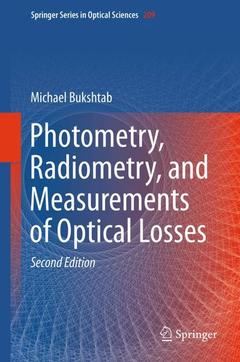Description
Photometry, Radiometry, and Measurements of Optical Losses (2nd Ed., 2nd ed. 2019)
Springer Series in Optical Sciences Series, Vol. 209
Author: Bukshtab Michael
Language: English
Subjects for Photometry, Radiometry, and Measurements of Optical Losses:
Keywords
Color Photometry; Laser Spectroscopy; Measurements of Optical Losses; Noise & Diffraction Corrections; Spectrophotometric Analysis; Applied photometric techniques; Applied radiometric techniques; photometric measurements; radiometric measurements; Practical optical measurement techniques; Frequency-comb spectroscopy; Laser-excitation spectroscopy; Fourier-transform Infrared spectroscopy; Time-and frequency-domain terahertz spectroscopy
797 p. · 15.5x23.5 cm · Hardback
Description
/li>Contents
/li>Biography
/li>Comment
/li>
The revised 2nd edition of this practical book provides an expanded treatment and comparison of techniques used in advanced optical measurements, guiding its reader from fundamental radiometric and photometric concepts to the state-of-the-art in highly sensitive measurements of optical losses and in spectroscopic detection using coherent laser light and spontaneous radiation. The book describes and compares a broad array of high-sensitivity methods and techniques ? from interferometric and/or calorimetric, acousto-optic and resonator or polarization to wavelength- and frequency-modulation, phase-shift and decay time studies, and direct-loss measurements for free-space, fiber- or waveguide-based systems and devices.
Updated throughout, the new edition describes novel trends in spectral interferometry, frequency-comb and laser-excitation spectroscopy, reflected in the developments of Raman, Brillouin and FTIR (Fourier Transform Infra-Red) techniques for biomedical research, biotech sensing and detection. It also covers broad practical implementations of time- and frequency-domain terahertz spectroscopy measurements.
This book reviews the physical concepts of radiation transfer, providing a quantitative foundation for the means of measurements of optical losses, which affect propagation and distribution of light waves in various media and in diverse optical systems and components. It focuses on the application of optical methods and procedures for the evaluation of transparent, reflecting, scattering, absorbing, and aggregated objects, and for determining the power and energy parameters of radiation and color properties of light. This updated new edition will serve as an up-to-date reference source and practical guide for those using photometric and radiometric techniques.
Introduction.- Chapter 1 Radiometric and Photometric Quantities and Notions Chapter.- 2 Methods of Photometric and Radiometric Measurements.- Chapter 3 Radiometry of Partially Coherent Radiation.- Chapter 4 Photometers and Radiometers Chapter.- 5 Conventional Loss-Measurement Techniques.- Chapter 6 Systems of Multiple Reflections.- Chapter 7 Laser Spectroscopy.- Chapter 8 Measurements in Passive Resonators.- Chapter 9 Determination of Absorption Losses Chapter.- 10 Direct Attenuation Measurements.- Chapter 11 Propagation Losses in Fibers and Waveguides.- Chapter 12 Spectroscopic interferometry and laser-excitation spectroscopy.
Michael A Bukshtab received M.S. and Ph.D. degrees in “Optical Design and Spectroscopy” and in “Physical Optics” from The State University of Information Technologies, Mechanics & Optics and from The Vavilov’ State Optical Institute, having the post-doctoral tenure analysing high-purity silica glasses and specialty fibres in The Institute of Silicate Chemistry, Academy of Sciences all in St. Petersburg (Leningrad), Russia. Michael's M.S. thesis received the Best Diploma Award among all Leningrad's technical universities and was published in “Measurement Techniques” in 1978. Michael’s monograph “The Low Loss Measurement Techniques”, 165 pages, was published in 1988 by Energoatomizdat, Moscow-Leningrad. The second book by M.A. Bukshtab, A. S. Doynikov, and V. N. Koromislichenko, “Photometry and Radiometry for Engineers” (editors M. A. Bukshtab and A. A. Wolkenstein) was left unpublished by Leningrad's Polytechnika. During the Perestroika movement Michael was elected by employees the Board Chairman for the Leningrad Institute of Telecommunications, where he served from 1989 until has immigrating to the United States in 1991. In the USA Michael worked on design, development, fabrication of optical systems and components for various companies, such as Sandoz, Corning, Pirelli, Kodak, CIENA, Lucent, GE Advanced Materials, and ASML. Michael experiences via MBOptical consulting includes designing complex systems and components and investigating various optical properties, while studying colour, polarization-dependent, backreflection, backscattering and other phenomena, developing wavelength-switching or cross-connect systems and OADM networks, working on optical routers and backplanes, investigating lithography and Fourier Transform Infrared Spectroscopy (FTIR) systems, researching augment reality displays, interferometric and diffraction-based positioning sensors, EDFA fibre-laser lidars, improving Brillouin-scattering confocal microscopy and interferometryfor




